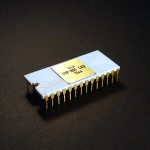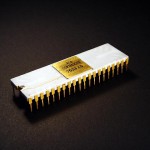General
|
General Information |
Most microprocessor collector’s are familiar with the RCA COSMAC 1802. The 1802 was RCA’s first single chip microprocessor. As a footnote it is mentioned that the 1802 is a single chip implementation of the two chip 1801. The first COSMAC and RCA’s first microprocessor is the CDP1801 (and the world’s 1st CMOS microprocessor). The designer of the microprocessor that came to be known as the 1800 series was Joe Weisbecker. He was inspired by the Intel 4004 and built his own microprocessor at home with TTL logic. When Jerry Herzog, learned of his work, he brought him into his group at the RCA Laboratories and he worked with his logic designers to create the 1801, 1802 etc.The COSMAC CDP1801 is implemented with the CDP1801R Microprocessor Register and CDP1801U Microprocessor Control. The segregation of function was necessary due trace size limitations, so the “R” provided ALU functionality and the “U” providing the control unit functionality.The fundamental architecture and technology of the 1801 was the same as the CDP1802. It was silicon gate CMOS and had similar packaging. The 1801 was slower at 2Mhz initially and then 4Mhz (1802 at 6.4Mhz). The 1802 (91 Op Codes) added many instructions, but was software compatible with the 1801 (59 Op Codes). The 1802 instruction additions beefed up the processor’s math and branching capabilities. The COSMAC architecture is classified as 8-bit (accumulator was 8-bits). However, the registers were 16-bit (and 8-bit) and processor had 16-bit addressing. The register oriented architecture made for very clean efficient programming.The 1801 was introduced in early 1975 and the 1802 in early 1976. The 1801 microprocessor and the COSMAC architecture were the first based on CMOS chip technology. CMOS chips could be suspended to save battery life, operated in extended temperature ranges, and were more tolerate of electronic interference. It is no wonder that the COSMAC was the first microprocessor in space. The 1801 flew on an OSCAR satellite launched in 1978. Other COSMAC spacecraft include UoSAT-1, UoSAT-2, Voyager (3 1802’s), Viking, and Galileo. The COSMAC’s that flew in space were space/radiation hardened versions using a CMOS/SOS chip technology. These radiation hardened versions were developed in conjunction with the Sandia National Laboratories. |
|
Production |
Early 1975 |
| Designers | Lead Designer: Joe Weisbecker, Team Lead: Jerry Herzog |
Architecture
| Type | Data Word | Address Space | Clock | Instruct- ions | Assists | Reg’s GP | Reg’s Math | Reg’s Index | IO Ports | Stack | Interrupts | Memory |
| 2 Chip CPU, CMOS | 8-bit | 64K | 2Mhz, 4Mhz | 59 | NA | 16×16-bit or 32×8-bit | 1 | NA | 8 | Ext RAM | 1 Level | NA |
Packages
Related Chips
|
Related Chips |
|
|
Second Sources |
None |
| Support Chips | 1852 (8-bit I/O Port), 1854 (UART), 1856 (4-bit memory buffer), 1857 (4-bit I/O buffer) |


